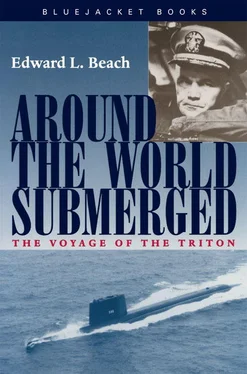We called this long drill period a “fast cruise,” and it deserved its name in more ways than one. We were fast to the dock, but the series of drills that were performed during those ninety-six hours were also fast—and very serious. Our day started at about 6:00 A.M. and ended roughly at 0200 the following morning. We stood watches around the clock as though actually under way—and an inherent submarine advantage immediately became apparent. The only time we consciously realized that we were still alongside the dock was when we held periscope drill.
I planned one of these drills to coincide with the moment the Patrick Henry, second of our Polaris-type submarines, slid down the ways into the Thames River. Her skipper, Commander (now Captain) H. E. Shear, USN, had been executive officer in Trigger II years ago, and this moment, when his great new ship was launched, was one I wanted to share with him. Patrick Henry hit the water two hundred yards forward of our bow, and I watched it all through the periscope.
The “fast cruise” over, a day to catch our breath and to load a few provisions aboard, and then the day of Triton ’s first under-way test, scheduled for Sunday, the twenty-sixth of September, 1959, was at hand.
Both Electric Boat Division and the Office of the Chief of Information, Navy Department, were anxious to get photographs. Someone, somewhere, had apparently decided that a blimp might be a better platform for photographs than the helicopters and airplanes usually used. I paid no attention; this was someone else’s affair. My job was to run the ship, and if proper authority wanted a blimp to join Triton at sea and photograph us as we put our ship through her paces, that was all right with me. But it was at this point and over this issue, at about eleven o’clock the night before we were to get under way, that it seemed for a time the trials would be delayed.
It had been a long, hard day, starting about 0500 when I had been called from my bunk in Triton. We had attempted to cover so much territory with our drills during the “fast cruise” that no one had had adequate sleep. Completing the “cruise” and making preparation for the next day’s excursion, we had been fighting our way through detail on detail. Hundreds of problems, apparently, still remained to be taken care of. I finally got home about 10:00 P.M., and was slowly unwinding before getting a restful sleep in anticipation of the morrow’s crucial trials. We were scheduled to get under way at 0630, which meant no more than six hours sleep; so my reaction to the telephone call that night was not a happy one.
On the other end of the wire an instantly recognized, irate voice demanded to know why I was having a blimp join Sunday’s operation. Vainly I protested that I knew nothing about the blimp, that my only interest was in carrying out the tests successfully. Admiral Rickover held that the blimp might crash at sea and that in this case we would waste valuable time fishing half-drowned sailors out of the water instead of carrying out the necessary trials. My arguments, that the safety record of the Navy’s lighter-than-air arm was better than that of aircraft, got nowhere. Although I wasn’t even sure who had ordered it, the discussion, if such it might be called, ended with my promise to cancel operations for the blimp—somehow.
Several phone calls later, this was successfully accomplished; no one seemed upset at the sudden change, except me—and possibly the people who had already journeyed to Lakehurst to board the airship. But the tension of the days and weeks just past suddenly gripped me. The last-minute “flap” over, I tossed and turned in my bed for hours, unable to sleep, unable to quiet my whirling brain, thinking out every detail, previewing every move I was to make with Triton in the morning.
A few months later, the very blimp that had been assigned to photograph us crashed at sea while searching for a lost sailboat, losing seventeen out of a crew of twenty.
Sunday morning, shortly before six, I arrived at the dock where Triton lay moored, bow pointing to sea. Dawn was showing to the east and a dull haze hung over the Electric Boat docks.
The special observers going to sea with us on this first day were already coming aboard. All was in readiness; I directed that lines to the dock be singled up and that a crane be hooked on to the remaining gangway to lift it off as soon as the last passengers were aboard. Finally, only Admiral Rickover, due to arrive at 6:30 A.M., was missing.
At precisely 6:30 A.M., accompanied by Carl Shugg, General Manager of Electric Boat Division, and Captain A. C. Smith, USN, Supervisor of Shipbuilding, the Admiral appeared at the head of the dock and marched rapidly toward us. Rickover, per his usual custom, was in civilian clothes and hatless.
Saluting, I said, “We are ready to get under way, sir!” I followed him up the gangway, gave the signal to the crane, and mounted to the bridge.
The Officer of the Deck was Lieutenant Robert Brodie, a tall, slender carbon copy of the Admiral Brodie I had met a few weeks earlier. He saluted me and formally reported, “Captain, the ship is ready to get under way in all respects.”
“Very well,” I responded, “I’ll take her. Stand by to relay orders for me.”
I stood on the bridge step alongside the rail. From this vantage point, I could see the entire forecastle and part of our afterdeck. Two more steps up brought me to the upper level of the bridge, the so-called “flying bridge” from which the entire length of the ship could be seen. There was no protection on this upper level, and the morning fog clung to my heavy woolens as I took a long look forward and aft. All was in readiness.
“Stand by to answer bells,” I called to Brodie on the bridge below me. He relayed the order via the bridge announcing system to the maneuvering room spaces. In a moment the bridge speaker squawked: “Bridge—maneuvering. Ready to answer all bells!”
I leaned forward. “Take in lines two, three, and four!” Then, “Slack one and five port, heave in one and five starboard.”
Triton slowly and steadily moved away from her dock. Moored stern-to in the slip for torpedo-tube tests, she had only to go ahead and angle right to clear some pilings which were dead ahead.
The moment of decisive test was at hand. Rudder, engines, and propellers had been thoroughly tested. We knew the turbines would work; we knew that everything would work. Yet this was the first time we were to try it. I felt a thrill of anticipation as I gave the next few commands.
“Rudder amidships!” I ordered. “All ahead one-third!”
I turned aft. In a moment, I could see the disturbed water turned up by the two propellers as they rotated slowly in response to my order. Both were moving in the right direction. Water was being pushed aft.
“Take in all lines!”
This was the climactic command, intentionally given late in order to retain our hold on the dock until the last possible moment. I heaved an involuntary sigh as our willing deck hands heaved the nylon cables swiftly aboard. Triton gathered way, moving slowly out of the slip where she had lain for so many months.
“Right ten degrees rudder!” I ordered. When you use rudder on a ship, you swing your stern away from the direction you wish to head. Too much rudder would send our port propeller crashing into the dock, but we had to come right because dead ahead were pilings indicating shallow water.
My initial estimate had been approximately right, I saw with pleasure, and the ship was answering her helm like the lady we hoped she was. As a matter of fact, she was coming around somewhat more rapidly than necessary.
“Ease the rudder to five right,” I ordered.
Читать дальше












